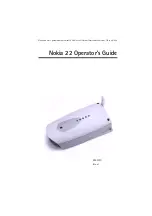
Third Party CTI Applications
The PBX supports industry standard protocols, allowing third-party CTI applications to be integrated with
the PBX and its extensions.
Voice Mail Features
A Voice Processing System (VPS) can be connected to the PBX to provide Voice Mail (VM) and Automated
Attendant (AA) services. A Panasonic VPS which supports DPT (Digital) Integration can be connected to the
PBX effortlessly and with minimal setup required. It can also be connected to one PBX in a network to provide
voice mail services for extensions at all PBXs. Conventional DTMF (analog) voice mail systems, including
those from other manufacturers, are also supported.
(
®
19.1.3 Voice Mail (VM) Group)
Paralleled Telephone Features
By connecting telephones in parallel, you can increase the number of telephones connected to the PBX without
adding additional extension cards.
(
®
13.1.2 Paralleled Telephone)
Parallel Mode
An SLT can be connected to an analog proprietary telephone (APT) or digital proprietary telephone (DPT)
that is connected to a Super Hybrid port of the PBX. The SLT shares the same extension number with the
APT or DPT.
EXtra Device Port (XDP) Mode
An SLT can be connected to a DPT that is connected to a Super Hybrid port of the PBX. Unlike parallel
mode, XDP mode allows each telephone to act as an independent extension with its own extension
number.
Digital XDP
A DPT can be connected to another DPT that is connected to a DPT port or a Super Hybrid port of the
PBX. Similar to XDP mode, each DPT acts as an independent extension with its own extension number.
Portable Station (PS) Features
A Panasonic PS (e.g., KX-TD7680, KX-TD7690) can be used in place of a PT to provide wireless access to
PBX features and call handling. When in Wireless XDP Parallel Mode, a PS can share an extension number
with a wired telephone, allowing extension users to use their PSs when they are away from their desks to
answer or make calls as if they were using their wired telephones.
Hospitality Features
This PBX has several features that support its use in a hotel-type environment. Extensions corresponding to
guest rooms can be "checked in" or "checked out" by a designated hotel operator, who can also check or set
wake-up calls.
(
®
8.1.4 HOSPITALITY FEATURES)
Simplified Voice Message (SVM) Features
By just installing an optional voice message card in the PBX, simple answering machine services can be
provided.
(
®
16.1.5 SVM (Simplified Voice Message))
Document Version 2008-11
Feature Manual
5
Introduction
Summary of Contents for KX-TDA50G
Page 13: ...Section 1 Features and Configurations A Document Version 2008 11 Feature Manual 13...
Page 26: ...26 Feature Manual Document Version 2008 11 1 1 7 Automatic Time Adjustment...
Page 27: ...Section 2 Features and Configurations B Document Version 2008 11 Feature Manual 27...
Page 30: ...30 Feature Manual Document Version 2008 11 2 1 1 BGM Background Music...
Page 31: ...Section 3 Features and Configurations C Document Version 2008 11 Feature Manual 31...
Page 66: ...66 Feature Manual Document Version 2008 11 3 1 21 CTI Computer Telephony Integration...
Page 67: ...Section 4 Features and Configurations D Document Version 2008 11 Feature Manual 67...
Page 90: ...90 Feature Manual Document Version 2008 11 4 1 11 Doorphone Call...
Page 91: ...Section 5 Features and Configurations E Document Version 2008 11 Feature Manual 91...
Page 102: ...102 Feature Manual Document Version 2008 11 5 1 9 External Sensor...
Page 103: ...Section 6 Features and Configurations F Document Version 2008 11 Feature Manual 103...
Page 124: ...124 Feature Manual Document Version 2008 11 6 1 7 FWD DND Button Group FWD Button...
Page 125: ...Section 7 Features and Configurations G Document Version 2008 11 Feature Manual 125...
Page 130: ...130 Feature Manual Document Version 2008 11 7 1 1 GROUP FEATURES...
Page 131: ...Section 8 Features and Configurations H Document Version 2008 11 Feature Manual 131...
Page 138: ...138 Feature Manual Document Version 2008 11 8 1 6 Hot Line...
Page 139: ...Section 9 Features and Configurations I Document Version 2008 11 Feature Manual 139...
Page 175: ...Section 10 Features and Configurations L Document Version 2008 11 Feature Manual 175...
Page 183: ...Section 11 Features and Configurations M Document Version 2008 11 Feature Manual 183...
Page 193: ...Section 12 Features and Configurations O Document Version 2008 11 Feature Manual 193...
Page 200: ...200 Feature Manual Document Version 2008 11 12 1 5 Operator Features...
Page 201: ...Section 13 Features and Configurations P Document Version 2008 11 Feature Manual 201...
Page 272: ...272 Feature Manual Document Version 2008 11 13 1 28 PT Programming...
Page 273: ...Section 14 Features and Configurations Q Document Version 2008 11 Feature Manual 273...
Page 276: ...276 Feature Manual Document Version 2008 11 14 1 2 Quick Setup...
Page 277: ...Section 15 Features and Configurations R Document Version 2008 11 Feature Manual 277...
Page 283: ...Section 16 Features and Configurations S Document Version 2008 11 Feature Manual 283...
Page 301: ...Section 17 Features and Configurations T Document Version 2008 11 Feature Manual 301...
Page 322: ...322 Feature Manual Document Version 2008 11 17 1 6 TRS Toll Restriction...
Page 323: ...Section 18 Features and Configurations U Document Version 2008 11 Feature Manual 323...
Page 325: ...Section 19 Features and Configurations V Document Version 2008 11 Feature Manual 325...
Page 346: ...346 Feature Manual Document Version 2008 11 19 1 5 Voice Mail DTMF Integration...
Page 347: ...Section 20 Features and Configurations W Document Version 2008 11 Feature Manual 347...
Page 354: ...354 Feature Manual Document Version 2008 11 20 1 4 Wireless XDP Parallel Mode...
Page 355: ...Section 21 Appendix Document Version 2008 11 Feature Manual 355...
Page 373: ...Index Document Version 2008 11 Feature Manual 373...
































